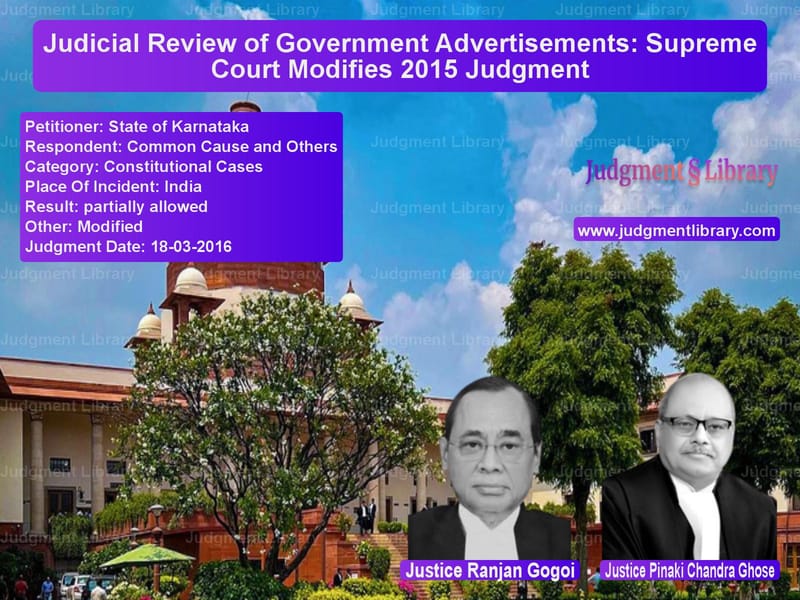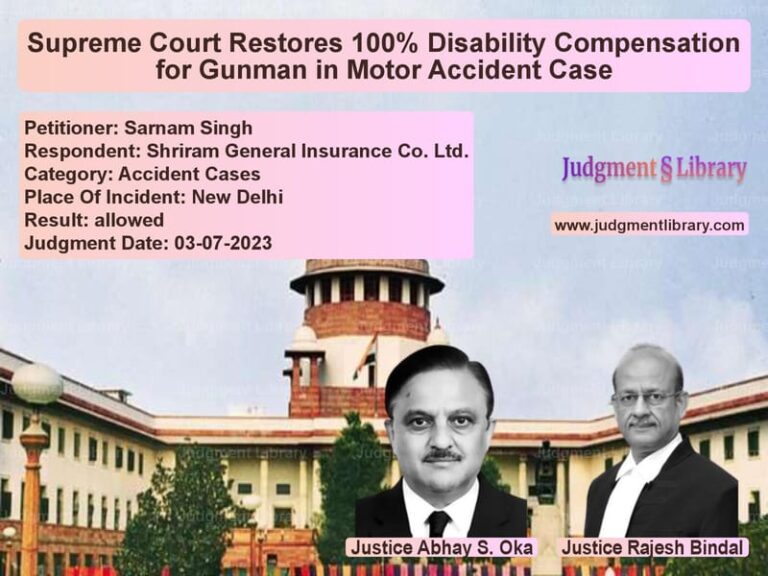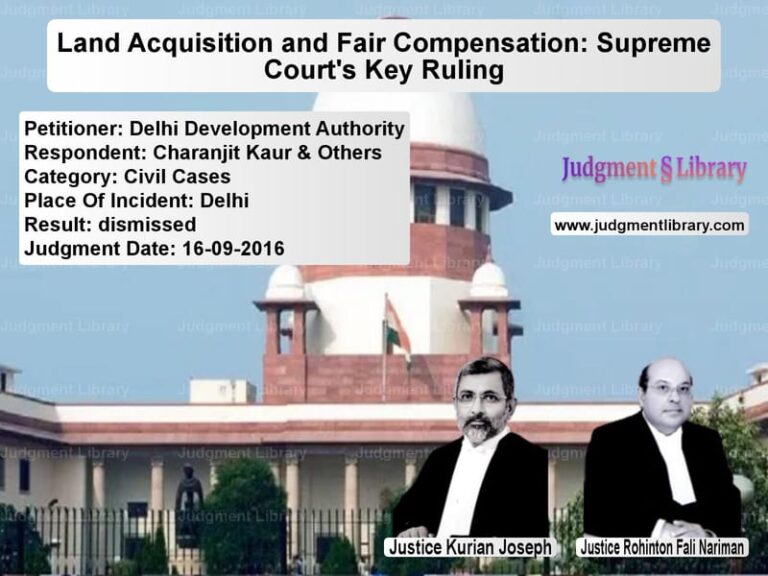Judicial Review of Government Advertisements: Supreme Court Modifies 2015 Judgment
The Supreme Court of India, in a landmark decision, revisited and modified its previous ruling from May 13, 2015, concerning the publication of government advertisements featuring photographs of public officials. The case arose from a series of review petitions filed by the State of Karnataka and other stakeholders against the public interest group Common Cause. The core issue revolved around the extent to which government advertisements could include images of political leaders, given concerns about the misuse of public funds for personal or political gain.
Initially, the Supreme Court, in its 2015 judgment, restricted the use of photographs in government advertisements to only the President, Prime Minister, and Chief Justice of India. This restriction was imposed to prevent undue political advantage and ensure public funds were utilized strictly for the dissemination of information in the public interest. However, following multiple review petitions from various states, the Court reconsidered certain aspects of its ruling.
Background of the Case
The litigation originated from concerns over the increasing use of public funds for political advertisements, where ruling parties would prominently display images of their leaders to gain electoral advantages. The public interest organization Common Cause, known for its efforts to promote transparency and accountability in governance, filed a writ petition challenging this practice. The petition argued that taxpayer money should not be used for the glorification of political figures but should be directed solely toward public welfare initiatives.
In response to these concerns, the Supreme Court in 2015 laid down strict guidelines restricting the use of government advertisements for political gains. The Court ruled that only the President, Prime Minister, and Chief Justice of India could have their photographs in government-funded advertisements. The logic behind this ruling was to ensure that political leaders could not misuse taxpayer funds for their own promotion.
However, following this judgment, several state governments filed review petitions, arguing that the restrictions placed on advertisements were too rigid and that Chief Ministers and Governors, who played significant roles in governance, should also be allowed representation in such advertisements. The State of Karnataka, along with other states, contended that excluding state leadership from advertisements undermined the authority of regional governments.
Legal Arguments by the Petitioner (State of Karnataka)
- The petitioner argued that restricting advertisements to only the President, Prime Minister, and Chief Justice was discriminatory against state-level leaders who also play a critical role in governance.
- The exclusion of Chief Ministers and Governors from advertisements prevented state governments from properly communicating important public welfare measures.
- The state contended that Chief Ministers and Governors, being constitutional functionaries, should have the same rights as their central counterparts when it comes to representation in government advertisements.
- The petitioner further argued that the ruling placed unnecessary restrictions on federalism, as it prevented states from effectively communicating their initiatives to the people.
Legal Arguments by the Respondent (Common Cause)
- The respondents maintained that the original judgment was necessary to curb the misuse of public funds for political propaganda.
- They argued that allowing additional political figures’ photographs in advertisements would dilute the purpose of the 2015 ruling and lead to the same problem it aimed to prevent.
- Common Cause contended that taxpayer money should not be used for self-promotion by political figures and should be spent solely on developmental initiatives.
- The respondents also pointed out that expanding the scope of allowable photographs in government advertisements could open the door for further abuse, leading to extensive politicization of state-funded campaigns.
Supreme Court’s Key Observations
The Supreme Court, after reviewing the arguments from both sides, made the following key modifications to its 2015 ruling:
- The exception permitting the use of photographs of the President, Prime Minister, and Chief Justice was extended to include Governors and Chief Ministers of the states.
- In lieu of the Prime Minister’s photograph, a government advertisement may feature the Departmental (Cabinet) Minister or Minister-in-Charge of the concerned ministry.
- In the states, similarly, the advertisement may include the photograph of the Departmental Minister-in-Charge instead of the Chief Minister, if so desired.
- All other observations and directions from the 2015 ruling remained unchanged.
Key Legal Precedents Considered
The Supreme Court relied on several legal precedents to frame its ruling, including:
- Common Cause v. Union of India (2015): The initial ruling that imposed restrictions on government advertisements.
- State of Tamil Nadu v. Union of India (2016): Examined issues related to federalism and the powers of state governments.
- Centre for Public Interest Litigation v. Union of India (2014): Addressed the principles of good governance and the importance of curbing the misuse of public resources.
Final Judgment and Its Implications
The Supreme Court’s judgment struck a balance between ensuring fairness in government communication and preventing misuse of taxpayer funds for political advertising. While the 2015 ruling was designed to eliminate political bias in government-funded campaigns, the modifications made in the review petition acknowledged the legitimate role of Chief Ministers and Governors in governance.
By extending the exemption to include Chief Ministers and Governors, the Court recognized the practical needs of state governments while maintaining strict guidelines to prevent the excessive use of public officials’ photographs for political gains. This decision ensures that government advertisements remain primarily informative and focused on public interest rather than serving as a medium for political promotion.
Conclusion
The ruling provides much-needed clarity on the limits of government advertisements while maintaining judicial oversight to ensure fairness. It serves as a precedent for future cases concerning the use of public funds in political promotions. The Supreme Court’s decision underscores the principle that governance should be transparent, accountable, and free from unnecessary political influence.
Don’t miss out on the full details! Download the complete judgment in PDF format below and gain valuable insights instantly!
Download Judgment: State of Karnataka vs Common Cause and Oth Supreme Court of India Judgment Dated 18-03-2016-1741853927702.pdf
Direct Downlaod Judgment: Direct downlaod this Judgment
See all petitions in Public Interest Litigation
See all petitions in Legislative Powers
See all petitions in Constitution Interpretation
See all petitions in Judgment by Ranjan Gogoi
See all petitions in Judgment by Pinaki Chandra Ghose
See all petitions in partially allowed
See all petitions in Modified
See all petitions in supreme court of India judgments March 2016
See all petitions in 2016 judgments
See all posts in Constitutional Cases Category
See all allowed petitions in Constitutional Cases Category
See all Dismissed petitions in Constitutional Cases Category
See all partially allowed petitions in Constitutional Cases Category







